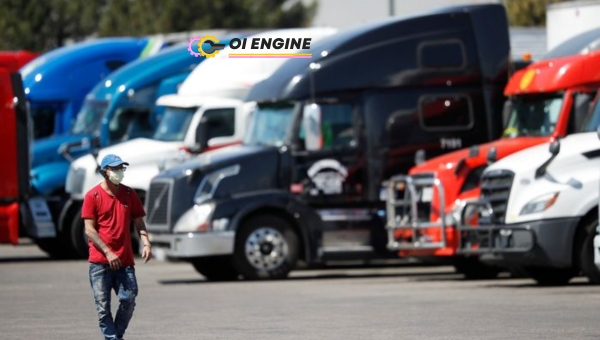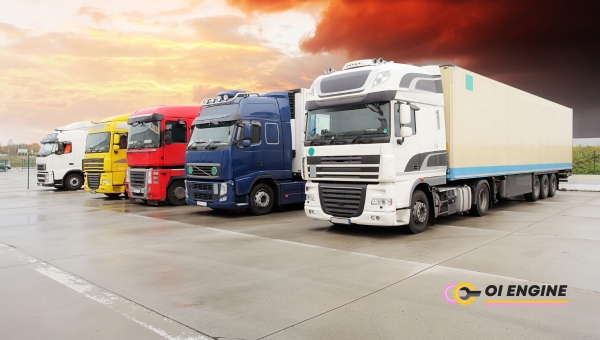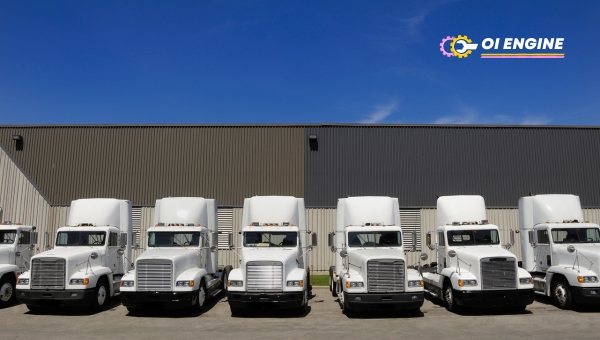It is undeniable how the pandemic e-commerce surge has altered our way of life. Who would have thought that this shift would drastically affect various sectors, most notably trucking? In just a split second, everything we know about shopping has taken a 180-degree turn!
Gone are the days when we can stroll in and out of retail stores. Now, it’s all about making a few taps on our screen and awaiting our orders delivered right to our doorstep. But behind this comfort lies an unspoken hero – the trucking industry.
Did you know that as e-commerce spiked due to the pandemic, so did the demand for truckers? The surge in online shopping heightened with strict stay-at-home orders meant businesses needed to rethink their delivery systems.
This sudden shift led to an immediate call for more drivers – those who could ensure that every order gets from warehouses to your homes safely and swiftly. But this rise in demand also presented certain challenges.
How the Pandemic E-commerce Surge Transformed the Trucking Industry?
The pandemic e-commerce surge didn’t merely alter people’s shopping habits, but it also caused a massive ripple effect across various sectors.

Among these, the trucking industry experienced a drastic transformation during this challenging period.
The Impact of the Pandemic E-Commerce Surge
The consequences brought about by the pandemic e-commerce surge were swift and dynamic. Suddenly, everyone started buying everything online – groceries, office supplies, home essentials – you name it.
- Immediate demand: Almost overnight, there was an unprecedented demand for truckers. This boom in e-commerce led to more goods being shipped and thus increased the need for truck drivers.
- Increases in deliveries: Deliveries weren’t just taking place in commercial areas anymore; residential deliveries skyrocketed as well.
- The shift in distribution networks: Traditional distribution setups had to be revamped as companies switched from delivering to stores to delivering directly to consumers’ front doors.
- Higher workload: The volume of goods that needed transporting became significantly higher due to each household buying separately rather than one large shipment made towards store chains.
- Operational changes: Transparency became vital; customers wanted real-time tracking abilities and arrivals needed to be prompt – increasing pressure on logistics operations.
Key Role of Truckers in E-Commerce Boom
The pandemic e-commerce surge rapidly prompted businesses both small and big scale alike to bank on digital sales channels.
Amidst this rush of orders pouring in because of online shopping spikes, truckers ensured seamless transitions.
- Dependability: More than ever before, societies depended on these essential workers – their role is critical for maintaining supply chains working fluidly during lockdowns.
- Changing landspaces: As retail businesses crumbled under lockdown restrictions while online businesses soared booming like never before – truckers adapted quickly traversing variable geographies and dropping off packages without breaks in customer satisfaction levels.
- Combatting shortages: Besides filling the gap of driver shortages amidst a pandemic, truckers fought supply chain interruptions to keep shelves stocked and customer orders delivered.
- Essential service provision: Truckers were elevated from their traditional roles into essential service providers, putting their health on the line to ensure goods reached consumers.
- Undeterred by Uncertainty: Even though facing unprecedented hurdles like virus mitigation rules and erratic restrictions in operations, truckers carried on ensuring the e-commerce machinery didn’t falter.
Also Read: How To Start A Trucking Company: A Guide
Probing The Driver Shortage Issue
One of the pressing issues born out of the pandemic e-commerce surge is a significant shortage of truck drivers. As online shopping experiences an unprecedented boom, the need for delivery services amplifies in parallel.
Now more than ever, we see how crucial truckers are to maintaining a steady supply chain and catering to consumer demands with timely deliveries.
Driver Shortages In Light Of The Pandemic E-Commerce Surge
Before delving into this issue, it’s helpful to truly grasp what ‘driver shortage’ means specifically in our present context.
A driver shortage doesn’t simply signify there aren’t enough people who know how to drive a truck – far from it! Instead, it refers to the dearth of professional drivers who have commercial driving licenses and are trained to haul goods over long distances in large vehicles.
The pandemic e-commerce surge has drastically amplified this shortfall. As more people turned toward online shopping amidst lockdown protocols and safety measures, companies started grappling with an increasing volume of orders.
Delivering these products efficiently required an extensive fleet of proficient drivers – something that was already lacking pre-pandemic.
Consequences And Implications Of The Truck Driver Shortage
The driver shortage isn’t just about late or missed deliveries; its ramifications extend far beyond inconvenienced customers waiting for their packages.
Here we highlight some possible impacts and long-term implications if this issue isn’t adequately addressed:
- Impaired business operations: Many businesses heavily rely on timely product deliveries for smooth operations. A consistent driver shortfall could delay or disrupt these processes leading to reduced efficiency.
- Price hikes: When demand surpasses supply in logistics services due to driver shortages, freight rates likely increase, which may be then passed onto consumers manifesting as higher prices for goods.
- Strained global supply chains: Goods often transit through multiple countries before reaching consumers as completed end-products. A serious deficit of truck drivers could place immense strain on these vital international logistic networks.
- Overworked existing workforce: The lingering driver shortage puts added pressure on current employees to cover longer routes or work extra hours, possibly leading to unhealthy stress levels and hastening employee burnout.
- Stunted economic growth: Logistics is the integral nerve of an economy, and any disruption may ripple across sectors hindering overall economic growth. Prolonged driver shortage would also mean fewer jobs in the market going unfilled.
The pandemic e-commerce surge and driver deficiency are interconnected. As demand accelerates, so does the requirement for drivers, which we currently struggle to fulfill.
This gap between necessity and availability has significant implications not only among businesses but also on a consumer level, ultimately affecting our economies at large.
Addressing Competition Amid Increasing Demand
As the pandemic e-commerce surge continued to increase, competition among carrier companies became fiercer.

Every piece of cargo became a battleground as these firms sought to meet expanding customer demand while maintaining profitable operations.
Intensified Carrier Companies Rivalry Due To Pandemic E-Commerce Surge
The shift towards online shopping brought about by the pandemic led to an intensified rivalry amongst carrier companies.
As more consumers opted for online purchases, trucking services were in high demand. This demand stirred up competition as every company strived to be at the forefront of this e-commerce boom.
- Increased pickup and delivery services: With many people staying indoors due to lockdowns and movement restrictions, companies with efficient pickup and delivery services enjoyed higher client preference over those with slow response periods.
- Expanded operation zones: Carrier companies correspondingly broadened their operational areas to reach more customers.
- Boosted advertising campaigns: In an attempt to stand out among many competitors, trucking businesses increased their marketing strategies.
- Enhanced customer service: Consumer satisfaction played a significant role in this cut-throat competition. Many firms enhanced their client support systems.
Strategies Implemented by Carrier Companies Amid Competition
While intense rivalry pushed some firms towards failure, others saw it as an opportunity for growth and implemented pertinent strategies that would give them a competitive edge.
- Efficiency upgrades: Distinguishing themselves from other businesses requires emphasizing efficiency in daily operations like timely delivery of goods and handling procedures.
- Focus on customer experience: These successful industry players made sure that all interactions that consumers had with them left a positive impression, thus enhancing confidence and loyalty among their clients.
- Innovation: Embracing modern systems or technologies that could advance their logistical processes’ efficiency such as automation systems for loading or unloading goods could maintain competitiveness.
- Stronger partnerships: Building stronger relationships with suppliers worked positively since it guaranteed reliable stock flow even during peak periods.
- Market research: It was of utmost importance to stay adrift of market trends and consumer preferences. Therefore, successful businesses invest comprehensively in research and development activities.
The pandemic e-commerce surge brought about its fair share of challenges and opportunities to carrier companies.
The fierce competition that arose did not only lead to business failures but also significant growth for those who embraced relevant strategies effectively.
Also Read: Find 14 Best Car Shipping Companies for Safe Delivery
Reckoning with Rising Employment Costs
The pandemic e-commerce surge, as amazing as it was for business profitability, led to some significant changes in the trucking industry.

One major shift centered around the escalating employment costs tied to truckers. With greater demand came increased pressure, and ensuring a smooth operation amid the chaos naturally called for higher expenditure.
The effects of this surgeon driver employment costs and potential future implications deserve an in-depth analysis.
Effects Of COVID and E-commerce Surge On Driver Employment Costs
The immediate aftermath of the pandemic e-commerce boom sparked notable changes in employment costs within the trucking industry:
- Increased Salaries: To incentivize existing drivers to meet soaring demands, many companies had no choice but to raise their base salaries.
- Recruitment Expenses: Finding new drivers wasn’t easy due to competition and COVID fears. As a result, firms spent more on advertising vacancies and recruitment drives.
- Health Benefits: In an era defined by a deadly virus, providing health benefits has become more critical than ever. Companies’ expenses spiked due to covering health insurance or related perks for their employees.
Future Implications And Trends For Trucking Expenses
Looking forward to an uncertain future shaped by both unpredicted challenges and possibilities, here are five possible trends that could impact cost-related decisions within the trucking world:
- Sustainable Salary Structures: Businesses will have to create sustainable payment strategies that not only appeal to recruits but ensure their long-term stay in these critical roles.
- Automated Trucking System Investment: To avoid heavy reliance on manpower alone, investing in automated truck systems may become essential—not only cutting down on labor costs but also guaranteeing process efficiency.
- Cheaper Insurance Rates Negotiations: Companies might need to negotiate cheaper insurance rates or find alternative ways of ensuring healthcare benefits for their employees without breaking the bank.
- Efficient Fuel Use Plans: Amid rising fuel prices, companies will need to establish policies to manage fuel efficiently, which could also bring down operational expenses.
- Driver Retention Strategies: Keeping existing drivers satisfied and motivated to stay on could lessen costs associated with hiring and training new personnel.
The trucking industry continues to adapt as we move farther into the post-pandemic era. Businesses within this sector need to prepare themselves for any potential cost-related changes and challenges ahead.
A Closer Look at Proposed Resolutions for 2024
As we find ourselves in the throes of the pandemic e-commerce surge, it’s crucial, now more than ever, to visualize what lies ahead.
The year 2024 may seem distant but indeed, it is not too far off and necessitates us to start considering strategies today for a smoother tomorrow.
Laying Out Future Strategies To Cope With Industry Challenges
The prevailing issues within the trucking industry warrant pressing attention. Ensuring we have effective solutions is vital to a healthier future for the industry.
- Implementing Advanced Technology: Embracing technical advancements can be a game-changer. GPS tracking systems and route optimization software could streamline operations and reduce overall costs.
- Focus on Retention: Prioritizing employee retention could address driver shortage issues. Offering competitive salaries, and benefits, and ensuring work-life balance could help retain skilled truckers.
- Enhancing Training Programs: Refined training methods can yield more capable drivers quickly—making driving tutorials more accessible and implementing simulator-based training can be some steps towards it.
- Regulatory Revisions: Rethinking laws related to driver hours-of-service could provide some level of flexibility for drivers and ensure their well-being.
Potential Impact Of These Strategies On The Post-Pandemic Era
If implemented successfully, these strategies carry the promising potential for adjusting in the post-pandemic era robustly:
- Improved Efficiency: Advanced technologies like GPS systems will make dispatches faster and routes more efficient.
- Lower Employee Turnover: Focusing on keeping existing workers happy has the potential to lower turnover rates lowering recruitment costs.
- Quality Hires: Better training programs would yield a skilled pool of drivers leading to fewer accidents or mishaps during deliveries.
- Happy Employees: Flexibility in regulations related to hours worked would mean happier employees leading to increased productivity levels.
- Sustainability: With better route optimization, fuel use could be minimized- contributing to a greener and more sustainable industry.
The success of these potential outcomes hinges on robust implementation coupled with consistent reassessment and adjustment according to market trends and demands. Achieving this balance is the way forward in a post-pandemic world for the trucking industry.
Also Read: Trailer Interchange Coverage-Protect Your Fleet!
Conclusion
After examining the pandemic e-commerce surge and its impact on the trucking industry, I comprehend how our consumption choices have far-reaching consequences that many of us may not readily consider.
From increased demand leading to trucker shortages to heightened competition between carrier companies, we’ve seen these changes firsthand.
Not only this, rising employment costs and potential strategies for future industry challenges have also been discussed in-depth.
The pandemic surely upended traditional business models, yet it simultaneously provided opportunities for new ways of operation.
What you and I saw as a mere shift from physical shopping to online purchases marked a watershed moment within the trucking sphere – proving once again that we’re all inherently connected in this modern economy.
